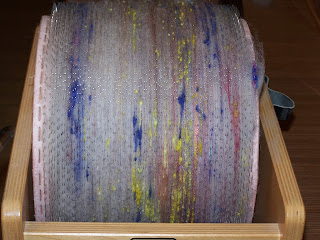They say core spinning is the "work horse" of the art yarn world, and indeed it does allow for lots of manipulation of your fibers. One of the beauties of core spinning is that it allows you to stretch your fibers farther and farther to end up, ultimately, with more yardage. A yarn needs structure so that it doesn't drift apart and leave you sweaterless, naked and cold. When spinning the vintage way, part of your fiber gets twisted into the center of your yarn, giving it that necessary structure and strength. But if you are spinning with expensive luxury fibers like angora, cashmere or buffalo down, you don't want it to disappear into the center of the yarn, never to be seen again. In core-spinning, you wrap your fiber around a pre-spun core so you don't lose any of your precious gold. And all fiber is precious gold in it's own way.
My first experience with core spinning was a really, really fun disaster. First I learned the basics of spinning in a 2-hour class at the Friends & Fiberworks Winter Retreat 2012. Then an hour later, I took a class in core spinning with Melissa Yoder Ricks of Wild Hare Fiber Studio. Was I ready to learn core spinning? No, I think not. I couldn't even spin the vintage way. But I had fun cramming all those bits & bobs onto my core--ribbon, beads, fiber, sequins, mohair locks. It still makes me smile to look at it today and to remember how I was so awed by Melissa's control and dexterity as she demonstrated at her wheel, wondering if my hands would spin magic like that. I was intimidated, I'll admit it. I mean, look at this hot mess.


If you've been following my blog, you know I've been working through Jacey Boggs Spin Art, one technique at a time. I've been stuck on core-spinning for a few weeks. And I don't mean stuck as in practicing until I got it right. I mean stuck as in afraid to dive in. Afraid to dive in, I realize, because I've been holding on to those "I'm not good enough...I'll never be able to spin like that" judgments left over from that first core-spinning class. And it wasn't even a bad experience. As I recall, I was exhilarated with the experience and thrilled with my yarn. Does this ever happen to you? That sometime in the interim between the first thrill of discovery and the moment of getting down to work to hone your skill, the little voice of unreasonable expectations in your head starts whispering its disheartening messages and, if you are not careful, it wins. It wins and then, if you are not paying attention, you give up. But if you are vigilant and looking out for that part of you that wants to lay down on the sofa with a bag of funyuns (good lord!) and the undertow of Facebook or Etsy or Seinfeld reruns ready to suck you down, you recognize that you have a choice. And sometimes you choose wisely. You choose to go to your studio, pick up your tools, make something even if it is bad, relish the making of the thing without regard for the end product. And you win. And tomorrow your choice is easier, and you win again. And every time you choose to go to your studio, that little voice gets smaller and smaller and smaller until it just gives up. And you keep winning like that...one victory at at time.
Thus ends the philosophical part of my post. Now for some pictures!
A page from the book....
 |
| Jacey Boggs: Spin Art, Mastering the Art of Spinning Textured Yarn |
Raw materials...hand painted polwarth, kettle dyed silk noil, sparkle (not shown but always present in my projects)
Raw materials hand carded into rolags. I was going for yarn that, when knit, ir reminiscent of confetti.
The core is a commercially produced cotton boucle thing that came on a cone, and that I prepared by spinning counter clockwise ("S"), so that when I spun my yarn clockwise ("Z"), it would wind up balanced. It ended up still a little twisted, so next time I'll put more Z twist in the core.
Pinch a little fiber in your spinning hand and draft a bit, then let it wind on the core at about a 90 degree angle.
Notice how the fibers, instead of being parallel to the length of the yarn as in traditional spinning, are perpendicular to the core--a signature of core spun yarn.
It's pretty.
And a little like confetti.
This is the same combination of fibers spun the traditional way, then plied.
It's pretty, too.
Here they are side by side. The 2-ply is fluffy and springy. The thickness of the core spun yarn depends on the thickness of your core. Mine was thin. As I was core spinning, it felt out of control and I thought that my yarn would be inconsistent and bumpy. But it evened out nicely after washing it and setting the twist.
I plan to knit some swatches today to see if it really looks like confetti. Meanwhile...I can't decide. I love them both!
"Your will is free, it is deliberately left free and you have to choose."
























































